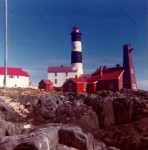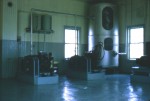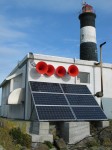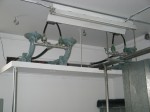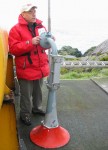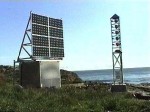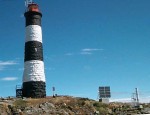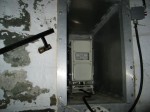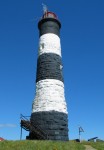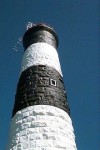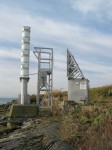- See this file on the Abiotic Factor of Fog
- In these photographs taken by the Andersons in the 1960’s, the original foghorn (diaphone) on the Race Rocks light station can be seen perched high on the wooden tower attached to the engine room.
- In this photo, the large compressed air storage tank sits in the corner of the engine room. Beside it is the Lister engine which ran the compressor. A former lightkeeper had decorated the tank with tweo murals.
- With the destruction of that tower to make way for modernization in the late 1970’s, a new foghorn was installed on the concrete block engine room. This video shows the demolition of the old fog tower. (ca 1976)
- This manual foghorn was used in emergencies.
- The Powers Brothers Ltd. Lunenburg Nova Scotia label which is attached to the manual foghorn.
- The old air chimes, still in place on the energy building at Race Rocks
- The air chime extensions inside the energy room.
- Barry MacDonald visiting from Nova Scotia explains the operation of the old air chimes which were made in Vancouver by Airchime. Most are now out of use on light stations.
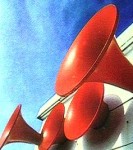 From the early 1980’s until January, 1997, fog or heavy rain impeding visibility in the eastern entrance of the Strait of Juan de Fuca would trigger three double tones per minute from the four trumpet shaped Airchime horns mounted on the South side of the engine room at Race Rocks.
From the early 1980’s until January, 1997, fog or heavy rain impeding visibility in the eastern entrance of the Strait of Juan de Fuca would trigger three double tones per minute from the four trumpet shaped Airchime horns mounted on the South side of the engine room at Race Rocks.
Click below to hear them:
- With the onset of full automation, the energy-demanding Airchime foghorn was replaced in January of 1997 with a new electronic version. This apparatus is erected below the tower near the old concrete foundation of the original engine room. On this foundation sits the solar panels and the storage batteries for the powering of the foghorn and the light signal on the tower. This fog signal yields a high pitched single tone, three times on the minute. The original design was replaced within two years as it was unreliable.
- The installation of the foghorn in 1999. The apparatus had just been lowered from a helicopter ..photos Courtesy of Don Gray, (CCG)
- The newly installed foghorn beside the solar panels which provide energy for both the light and the foghorn.
- During the day, these windows are perfectly positioned so that the inside of the tower was illuminated by natural light for the complete ascent. When the automated fog signal was installed the south window was blocked with the fog sensor
- The inside view of the fog sensor instrument. It is positioned so that it points out over the Strait from the window on the south side of the tower. See photos to the right.
- Now the fog sensor is located in the small window, half-way up the tower facing South.
- It points out over the Strait of Juan de Fuca and initiates the fog signal when fine water droplets are encountered in the atmosphere.
- Foghorn and solar panel in 2007.
click on bar below for the current foghorn


